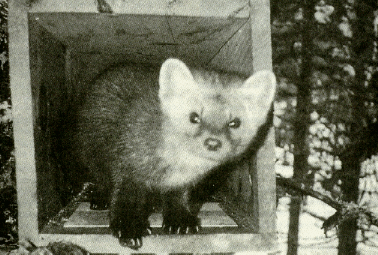
SPRING 1995
The Previous issue of Conservation (Elusive Ghosts of the Deep Forest) contained an article on pine martens and their possible existence on Cape Breton Island. The article detailed an experiment being carried out by Department of Lands and Forestry' staff to track martens. Well, department staff have confirmed the existence of this small animal in Cape Breton through the use of tracking boxes. A conservation officer and wildlife biologist in the Baddeck office have photographs of pine marten. In fact, this marten helped prove it's own existence.

This marten may look surprised at being photographed, but it actually tripped the shutter of the camera that took its photograph. Photo:DNR
During the winter of 1993-94, staff began examining mature softwood forest sites for any signs of martens. Special wooden boxes were fastened to trees in selected areas and baited with pieces of meat from road killed deer. No martens were located. Last fall, staff concentrated their activities in one area. It soon became evident that one bait site was being visited by an unfamiliar mammal. Tracks left in the snow were unlike any researchers had seen before.
"Christmas came early for me this year," says biologist Dan Banks, as he described what happened on December 20, 1994.
"I accompanied conservation officer Blowers Stubbert by snowmobile to the site where he had been seeing the strange tracks," he says. "It was snowing very hard. We left the machines and walked into the stand of old white spruce. There were fresh tracks on the ground in spite of the rapidly accumulating snow. Sure looked like rabbit tracks to me, except that they approached the base of a large old spruce three and simply vanished into the solid tree trunk. Rabbits don't climb trees. Martens climb trees."
"From about 30 feet up the spruce looking down at us was the first wild marten I had ever seen in Nova Scotia. I'll never forget the experience," Banks remarks.
The two men set up special camera equipment and timing devices at the bait site. Later that day, the marten returned to the bait. By breaking an invisible infrared beam that tripped the shutter mechanism on the camera, the animal took its own portrait.